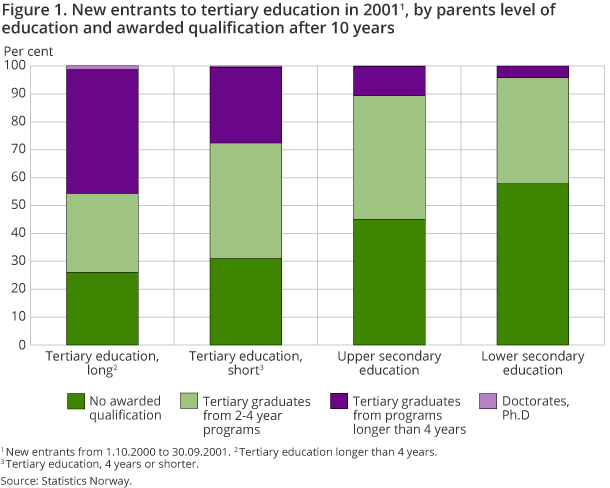Content
Published:
This is an archived release.
More men dropping out of nursing courses
Four out of every 10 men who enrolled on a nursing education programme in 2007 did not complete the course within 5 years.
| Total | Males | Females | |
|---|---|---|---|
| 1Students who enrolled in tertiary education for the first time from 1.10.yyyy-1 to 30.09.yyyy. (Example. the year of start 1999, will be started the period 1.10.1998-30.9.1999) | |||
| 20011 | |||
| Total | 41 390 | 16 679 | 24 711 |
| Doctorates, Ph.D | 214 | 141 | 73 |
| Tertiary graduates from programmes longer than 4 years | 7 669 | 3 631 | 4 038 |
| Tertiary graduates from programmes lasting 2-4 years | 16 092 | 4 729 | 11 363 |
| No awarded qualification | 17 415 | 8 178 | 9 237 |
| Per cent | |||
| Total | 100.0 | 100.0 | 100.0 |
| Doctorates, Ph.D | 0.5 | 0.8 | 0.3 |
| Tertiary graduates from programmes longer than 4 years | 18.5 | 21.8 | 16.3 |
| Tertiary graduates from programmes lasting 2-4 years | 38.9 | 28.4 | 46.0 |
| No awarded qualification | 42.1 | 49.0 | 37.4 |

For the cohort who began their nursing education in 2005, 3 out of 10 men did not complete the course within 5 years. The corresponding share for women was unchanged at 2 out of 10.
Growing number of students not completing a degree
Of the roughly 41 400 new students who enrolled in tertiary education in autumn 2001, 42 per cent had not completed their degree ten years later. Compared with the students who enrolled ten years previously, this is an increase of 11 percentage points. Male students continue to have the highest drop-out rate. In the 2001 cohort, half of the male students did not complete their degree within ten years. The corresponding share for women was slightly below 37 per cent.
Parents’ education counts
Students whose parents’ highest level of education is lower secondary make up the largest share of students who do not complete their degree. The higher the education that one of the parents has, the more likely it is that a student will complete a degree within ten years. Of the new students from 2011 whose parents had a long tertiary education, just short of 74 per cent had attained a degree within ten years. By comparison, the corresponding share for students whose parents only had a lower secondary education was around 42 per cent.
The greatest disparity is among students on degree programmes lasting more than four years. Forty-six per cent of the students whose parents had a long tertiary education completed a degree programme lasting more than four years. The corresponding share for students whose parents only had a lower secondary education was just below 4 per cent.
Nearly a quarter of all bachelor students drop out
Around 30 000 students enrolled on a bachelor’s degree programme for the first time in 2007, and 45 per cent of these completed their studies within three years. After a further two years, 62 per cent had completed their degree. This is the same share as the students who enrolled in 2006. During this five-year period, 20 per cent dropped out, and 7 per cent of these dropped out after the first year. The bachelor degree in economics and administration subjects had the highest share of students who dropped out within five years, with 31 per cent.
No change in number of engineering students attaining a degree
In autumn 2007, more than 2 800 students enrolled on engineering studies for the first time. Fifty-five per cent of these completed a degree within three years. After a further two years, 65 per cent had completed their studies. Compared with students who enrolled in 2006, there was no change, with one in every five engineering students dropping out during the five-year period.
Increase in numbers completing teaching education
Of the students who enrolled in the general teaching training programme in 2006, 62 per cent had completed their course within six years. For those who enrolled two years earlier, in 2004, the completion rate was 56 per cent. The share of male students completing their course increased from 45 to 55 per cent, and the women saw an increase from 61 to 65 per cent. Compared with students who enrolled in 2005, there was no significant change.
Completion timeOpen and readClose
Completion time is calculated based on the number of years since the student was first enrolled in tertiary education. In tables showing students beginning individual studies, completion time is calculated based on the number of years since the student enrolled on the particular study programme for the first time. Students who do not complete within the expected completion time may have studied part time, or had to interrupt their studies during the programme, or changed course or completed another programme earlier.
Contact
-
Jane Bekkengen
E-mail: jane.hansine.bekkengen@ssb.no
tel.: (+47) 40 81 13 52
-
Geir Nygård
E-mail: geir.nygard@ssb.no
tel.: (+47) 48 15 13 44
-
Nawid Fazli
E-mail: nawid.fazli@ssb.no
tel.: (+47) 97 09 77 18
